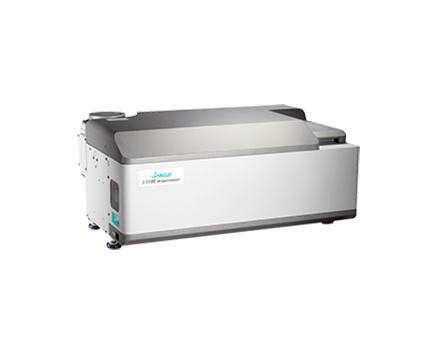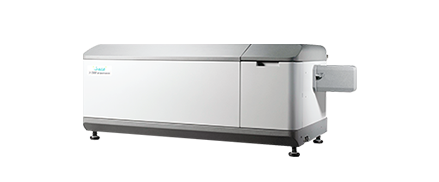Measurement of alanine powder using DRCD with multiprobe function
January 5, 2024
Introduction
While CD samples must typically be in solution or a transparent film in order to perform CD measurements, there has recently been an increasing demand for CD measurements on insoluble samples or samples that change conformation in solution. These samples must be performed in a solid state and while CD transmission measurements can be made on solid samples, the preparation requires the sample to be made into a pellet form. In addition, if sample dilution is required, it is not easy to recover the sample. A way of overcoming the difficulties of transmission measurements in the solid state is to use diffuse-reflectance CD (DRCD).
Diffuse reflectance is incident light that is scattered off a surface in different directions. In DRCD, the spectrometer beam focuses on the powdered sample and through the use of an integrating sphere, the diffusely reflected light is collected (Figure 1A). This makes DRCD an excellent technique for solid samples. However, during CD measurements of solid samples, the influence of LD (linear dichroism) derived from the optical anisotropy of the solid sample may have to be taken into consideration to minimize any artifacts in the CD spectrum. The J-1500 CD allows spectrometer the user to make a simultaneous measurement using a multi-probe digital quad lock-in amplifier for both CD and LD. The measurement of the CD and any artifacts can be made without a second measurement.
This application note illustrates the DRCD measurement using the DRCD-575 accessory (Figure 1B) and the J-1500 CD spectrometer with multi-probe functionality. This is demonstrated by an example DRCD measurement using powdered L- and D-alanine.
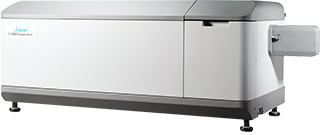
Experimental
Figure 1A shows that the diffuse reflectance can be measured by placing a powdered sample opposite the inlet port of the incident light and placing the detector in close contact with the integrating sphere (90° to the axis of the incident light). A diffuse-transmission measurement can be made when a sample is set at the inlet port of the incident light and a diffuse plate or white plate is located at the sample position to collect the diffuse reflectance. In diffuse transmission, sample dilution is often requires and small sample amounts can be measured.
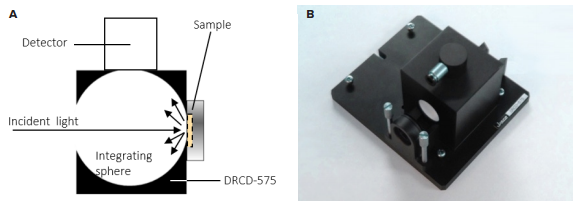
| System Configuration | |||
|---|---|---|---|
| Model | Description | P/N | |
| Main unit | J-1500-450ST | CD spectrometer¹ | 7000-J006A |
| Accessory | PLM-534 | FDCD PMT detector | 7069-J034A |
| FLM-525 | N2 gas flow meter | 7069-J025A | |
| DRCD-575 | Solid-state (powder) CD measurement unit2,3 | 7069-J075A |
¹This application can also be performed using the J-1500-150ST (P/N 7000-J005A). 2Powder CD unit can be applied to the transmission measurement using KBr pellet method. ³The cell holder for powdered sample is a standard item in the DRCD-575 accessory
| >Measurement conditions | |
|---|---|
| Data acquisition interval | 0.1 nm |
| Response time | 1 sec |
| Spectral bandwidth | 2 nm |
| Scan speed | 100 nm/min |
| Accumulations | 5 times |
Keywords
260-CD-0020, J-1500, Circular Dichroism, CD, linear dichroism, diffuse reflectance CD, DRCD-575, solid state, multi-probe, biochemistry
Results
The DRCD and DRLD spectra of L- and D-alanine powdered samples are shown in Figure 2. In the CD mode, the L- and D-alanine spectra obtained are mirror images of one another with the same intensity. In the LD mode, the signal intensity of each spectrum is less than ± 0.005 ΔOD, which is small enough to not contribute significantly. These results indicate that the influence due to optical anisotropy is negligible.
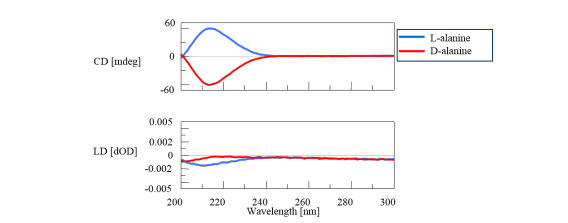
Conclusion
This application confirms that the DRCD-575 Powder CD unit and the J-1500 spectropolarimeter with multi-probe function can be used for DRCD measurements of well-ground powder amino acid samples. This measurement technique could easily expand the application of solid-state CD to metal complexes and super molecule samples.
References
- E. Castiglioni and P. Albertini, Chirality (2000), 12, 291-294.
- Qiu, H., Inoue, Y., and S. Che, Angew. Chem. Int. Ed (2009), 48, 3069-3072.
Featured Products:

Measurement of alanine powder using DRCD with multiprobe function
Introduction
While CD samples must typically be in solution or a transparent film in order to perform CD measurements, there has recently been an increasing demand for CD measurements on insoluble samples or samples that change conformation in solution. These samples must be performed in a solid state and while CD transmission measurements can be made on solid samples, the preparation requires the sample to be made into a pellet form. In addition, if sample dilution is required, it is not easy to recover the sample. A way of overcoming the difficulties of transmission measurements in the solid state is to use diffuse-reflectance CD (DRCD).
Diffuse reflectance is incident light that is scattered off a surface in different directions. In DRCD, the spectrometer beam focuses on the powdered sample and through the use of an integrating sphere, the diffusely reflected light is collected (Figure 1A). This makes DRCD an excellent technique for solid samples. However, during CD measurements of solid samples, the influence of LD (linear dichroism) derived from the optical anisotropy of the solid sample may have to be taken into consideration to minimize any artifacts in the CD spectrum. The J-1500 CD allows spectrometer the user to make a simultaneous measurement using a multi-probe digital quad lock-in amplifier for both CD and LD. The measurement of the CD and any artifacts can be made without a second measurement.
This application note illustrates the DRCD measurement using the DRCD-575 accessory (Figure 1B) and the J-1500 CD spectrometer with multi-probe functionality. This is demonstrated by an example DRCD measurement using powdered L- and D-alanine.

Experimental
Figure 1A shows that the diffuse reflectance can be measured by placing a powdered sample opposite the inlet port of the incident light and placing the detector in close contact with the integrating sphere (90° to the axis of the incident light). A diffuse-transmission measurement can be made when a sample is set at the inlet port of the incident light and a diffuse plate or white plate is located at the sample position to collect the diffuse reflectance. In diffuse transmission, sample dilution is often requires and small sample amounts can be measured.

| System Configuration | |||
|---|---|---|---|
| Model | Description | P/N | |
| Main unit | J-1500-450ST | CD spectrometer¹ | 7000-J006A |
| Accessory | PLM-534 | FDCD PMT detector | 7069-J034A |
| FLM-525 | N2 gas flow meter | 7069-J025A | |
| DRCD-575 | Solid-state (powder) CD measurement unit2,3 | 7069-J075A |
¹This application can also be performed using the J-1500-150ST (P/N 7000-J005A). 2Powder CD unit can be applied to the transmission measurement using KBr pellet method. ³The cell holder for powdered sample is a standard item in the DRCD-575 accessory
| >Measurement conditions | |
|---|---|
| Data acquisition interval | 0.1 nm |
| Response time | 1 sec |
| Spectral bandwidth | 2 nm |
| Scan speed | 100 nm/min |
| Accumulations | 5 times |
Results
The DRCD and DRLD spectra of L- and D-alanine powdered samples are shown in Figure 2. In the CD mode, the L- and D-alanine spectra obtained are mirror images of one another with the same intensity. In the LD mode, the signal intensity of each spectrum is less than ± 0.005 ΔOD, which is small enough to not contribute significantly. These results indicate that the influence due to optical anisotropy is negligible.

Conclusion
This application confirms that the DRCD-575 Powder CD unit and the J-1500 spectropolarimeter with multi-probe function can be used for DRCD measurements of well-ground powder amino acid samples. This measurement technique could easily expand the application of solid-state CD to metal complexes and super molecule samples.
Keywords
260-CD-0020, J-1500, Circular Dichroism, CD, linear dichroism, diffuse reflectance CD, DRCD-575, solid state, multi-probe, biochemistry
References
- E. Castiglioni and P. Albertini, Chirality (2000), 12, 291-294.
- Qiu, H., Inoue, Y., and S. Che, Angew. Chem. Int. Ed (2009), 48, 3069-3072.

 Download This Application
Download This Application